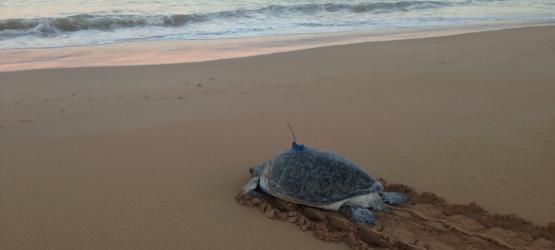A first-of-its-kind study has mapped the global movements of a range of marine animals around the world, including whales, sharks, sea birds and polar bears, to understand how they travel the ocean.
The analysis revealed that despite significant differences in body size, shape and mode of movement, marine animals move through the ocean in similar ways.
The study published this week in the journal PNAS, was led by researchers, from The University of Western Australia and the Australian Institute of Marine Science. It was the result of a worldwide collaborative effort from researchers involved in the Marine Megafauna Movement Analytical Program (MMMAP).
The researchers analysed the satellite tracking data of more than 2,500 tagged marine animals from 50 species, looking at their speed and movement patterns. Some of the tracks extended back to 1985.
Unlike terrestrial species, where movement is commonly associated with body size, the team was surprised to find that unrelated marine species displayed similar movement patterns. For example, one-tonne whales display comparable movement patterns to seabirds weighing a few hundred grams.
The differences found across all species were associated with where these species were moving, and is potentially linked with the way they use different marine habitats.
The study also revealed that movement in oceanic habitats was more directed (straight towards a key location) while in coastal environments movement was more complex, suggesting animals adapt their behaviour when closer to shore, potentially in search of food, or for protection.
This ability to adapt their behaviour to their habitat provides hope of these animals’ higher resilience to a rapidly changing, coastal marine environment.
Lead author Dr Ana Sequeira, from the UWA Oceans Institute said it was important to understand how animals adapt their movement patterns to different environments, particularly as rapid changes are taking place in the ocean, with potentially profound effects on the conservation of these species.
“Understanding drivers of animal movement is crucial to assist mitigating adverse impacts of anthropogenic activities on marine megafauna,” Dr Sequeira said.
“While the results of the study suggest marine species have adapted to different properties of the inshore and offshore marine environment, it is still important to understand how, and how fast, they can adapt.”
“This is particularly important to guide conservation management in view of the forecasted severe ocean changes, including sea level rise and reduced Arctic sea ice cover.”
Co-author Dr Michele Thums from the Australian Institute of Marine Science said the differences between on-and offshore movements most likely related to habitat differences.
“Inshore habitats such as reefs and seagrass are generally more complex compared to open ocean habitats offshore, and are therefore stimulating more complex movement patterns in these animals,” Dr Thums said.
Dr Sequeira aims to expand this research to investigate global interactions between vessels and marine megafauna and invites potential data contributors to get in touch and become part of the extended MMMAP group.
Dr Sequeira is a UWA DECRA fellow funded by the Australian Research Council.
MEDIA REFERENCE:
Jess Reid (UWA Media and Public Relations Advisor) (+61 8) 6488 6876
Dr Ana Sequeira (UWA Oceans Institute) (+61 8) 6488 2219/ 0430 072 253
Emma Chadwick (AIMS Communications Officer) (+61 7) 4753 4452 / 0412 181 919
Media enquiries
Emma Chadwick
Communications Officer
Australian Institute of Marine Science, Townsville
Phone: +61 0412 181 919
Email: e.chadwick@aims.gov.au


